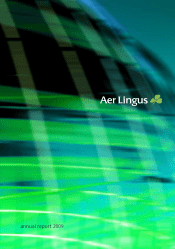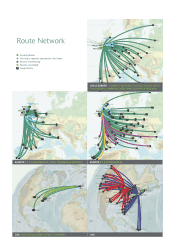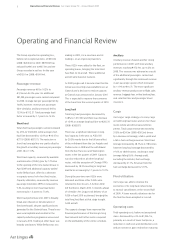Aer Lingus 2009 Annual Report Download - page 8
Download and view the complete annual report
Please find page 8 of the 2009 Aer Lingus annual report below. You can navigate through the pages in the report by either clicking on the pages listed below, or by using the keyword search tool below to find specific information within the annual report.
Operating and Financial Review Aer Lingus Group Plc – Annual Report 2009
The Group reported an operating loss,
before net exceptional items, of €81.0m
(2008: €20.0m) for 2009. EBITDAR has
reduced by €45.6m to €57.5m and the
Group recorded a net loss for the year
of €130.1m (2008: €109.9m).
Passenger revenue
Passenger revenue fell by 10.2% to
€1,166.6m for the year. An additional
381,000 passengers were carried compared
to 2008. Average fare per passenger fell by
16.8%; however, revenue per passenger
(fare yield plus ancillary revenue) fell by
13.5% to €112.37. Total passenger load
factor increased by 1.7 points to 74.5%.
Short haul
Total short haul passengers carried increased
by 6.5% to 9,305,000, while average short
haul fare decreased by 12.0% or €10.47 to
€77.10 (2008: €87.57). The reduction in
short haul average fare was partly offset by
the growth in ancillary revenue per passenger
of €1.78 or 11.9%.
Short haul capacity, measured by available
seat kilometres (ASKs) grew by 7.2% due
to the opening of the new Gatwick base in
April 2009 and additional capacity added
to the Belfast base, offset by a decrease
in capacity across Irish short haul routes.
Capacity utilisation, measured by revenue
passenger kilometres (RPKs) increased by
9.4% resulting in short haul load factor
increasing by 1.5 points to 75.4%.
Short haul performance for 2009 is broadly
break-even (based on full allocation of
fixed overheads), despite significant losses
generated by the Gatwick base. These losses
were unacceptable and resulted in the
capacity reduction programme announced
in January 2010. Trading at other bases was
broadly satisfactory. While Belfast was loss-
making in 2009, it is a new base and its
trading is on an improving trajectory.
Three A320s were added to the fleet, on
operating leases, bringing the total short
haul fleet to 36 aircraft. These additional
aircraft were based at Gatwick.
As 2009 progressed it became clear that the
Group was incurring unacceptable losses at
Gatwick and a decision to reduce capacity
at Gatwick was announced in January 2010.
This is expected to improve the economics
of the base from the second quarter of 2010.
Long haul
Total long haul passengers decreased by
14.8% to 1,077,000 and there was decrease
of 15.9% in average long haul fare to €255.70
(2008: €303.87).
There was a significant decrease in long
haul capacity in the year, as ASKs fell
by 20.3% mainly due to the full year effect
of the withdrawal from the Los Angeles and
Dubai routes in 2008 and the withdrawal
from the San Francisco and Washington
routes in the last quarter of 2009. Capacity
was also reduced on all other long haul
routes, with the exception of Chicago. RPKs
decreased by 18.3% resulting in long haul
load factor increasing by 1.7 points to 73.1%.
During the year two new A330s were
delivered and three other A330s were
returned to their lessors. A further A330
left the fleet in March 2010, 14 months ahead
of schedule. Aer Lingus took delivery of an
A330 in April 2010 as planned, bringing the
total long haul fleet at that stage to eight
A330 aircraft.
The capacity changes have improved the
financial performance of the Group’s long
haul network but further work is required
on the profitability of the winter schedule.
Ancillary
Ancillary revenue showed another strong
performance in 2009, with total ancillary
revenues reaching €173.9m, up 16.2% on
2008. This increase was achieved as a result
of the additional passengers carried and,
significantly, through the continued increase
in per passenger spend, which increased
by 11.9% to €16.75. The most significant
ancillary revenue products are in-flight sales
revenue, baggage fees, online booking fees,
seat selection fees and passenger travel
insurance.
Cargo
Aer Lingus’ cargo strategy is to carry cargo
on both long haul routes and on short haul
routes where aircraft turnaround times
permit. Total cargo revenue decreased by
31.8% to €34.3m (2008: €50.3m) driven
by a decrease in tonnage, a fall in yields and
a fall in fuel surcharge revenue. Short haul
tonnage increased by 48.1% to 6,718 tonnes;
however long haul tonnage decreased by
19.6% to 18,815 tonnes, resulting in total
tonnage falling 8.6%. Average yield,
excluding the industry fuel surcharge,
decreased by 21.7%. Revenue from the
fuel surcharge decreased by 51.9%.
Fleet utilisation
Aer Lingus was able to improve the
economics of its long haul network due
to tactical cancellations in the second half
of 2009. A lower aircraft utilisation rate for
the fleet has been accepted as a result.
Operating costs
Total operating costs, before net exceptional
items, decreased by 6.4% to €1,286.7m,
primarily as a result of lower fuel prices, a
reduction in staff costs and distribution costs
and an increase in gains realised on maturing
Operating and Financial Review





















